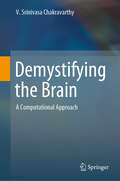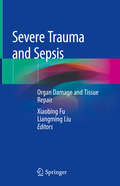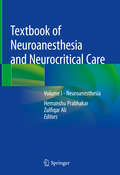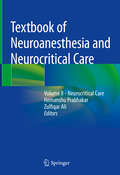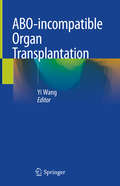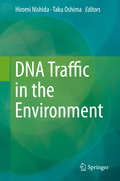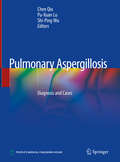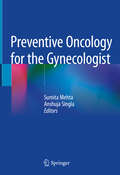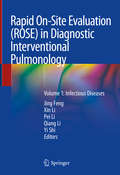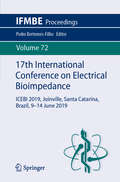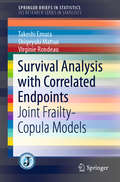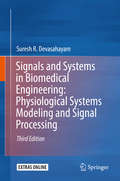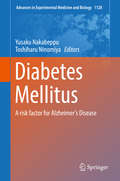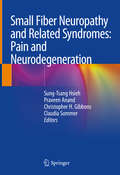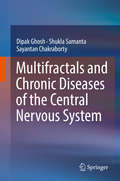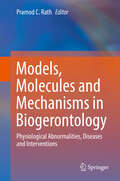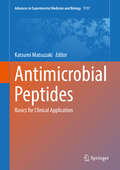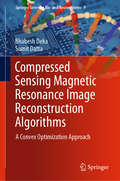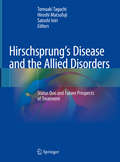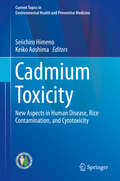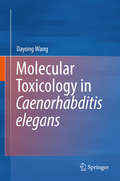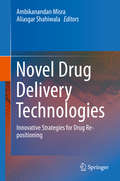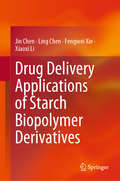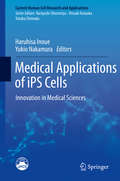- Table View
- List View
Demystifying the Brain: A Computational Approach
by V. Srinivasa ChakravarthyThis book presents an emerging new vision of the brain, which is essentially expressed in computational terms, for non-experts. As such, it presents the fundamental concepts of neuroscience in simple language, without overwhelming non-biologists with excessive biological jargon. In addition, the book presents a novel computational perspective on the brain for biologists, without resorting to complex mathematical equations.It addresses a comprehensive range of topics, starting with the history of neuroscience, the function of the individual neuron, the various kinds of neural network models that can explain diverse neural phenomena, sensory-motor function, language, emotions, and concluding with the latest theories on consciousness. The book offers readers a panoramic introduction to the “new brain” and a valuable resource for interdisciplinary researchers looking to gatecrash the world of neuroscience.
Severe Trauma and Sepsis: Organ Damage and Tissue Repair
by Xiaobing Fu Liangming LiuThis book discusses recent progress in organ damage and tissue repair following severe trauma and sepsis. In part 1, it introduces the theory and clinical practice in organ damage. In part 2, it covers all the subjects of sepsis, ranging from mechanism, inflammation, and infection to the lung injury and neonatal sepsis. In part 3, it discusses 4 new advances techniques in tissue repair. There are 20 chapters contributed by experts in each area.This book is a valuable reference for scientists and clinicians to know the new knowledge and technology in severe trauma and sepsis, which will benefit their work in research and clinic through multidisciplinary collaboration.
Textbook of Neuroanesthesia and Neurocritical Care: Volume I - Neuroanesthesia
by Hemanshu Prabhakar Zulfiqar AliThis two-volume book offers a comprehensive guide to anesthetic management and critical care management in neurosurgical and neurological patients. This first volume focuses on neuroanesthesia. The book begins with basic information on neuroanesthesia, extensively discussing the anatomy of the brain and spine, physiology and relevant pharmacology. Special considerations for pregnant, pediatric and geriatric patients are covered in separate chapters. Each neurosurgical condition is discussed in a standard format relevant for neurosurgical patients, and each chapter, prepared by experts in the field, includes ample illustrations and flowcharts. Information is also provided on the latest evidence-based approaches, robotic surgery and gene therapy. The book offers a valuable resource for all residents, fellows and trainees in the fields of neuroanesthesia and anesthesia; it will also benefit practitioners and consultants.
Textbook of Neuroanesthesia and Neurocritical Care: Volume II - Neurocritical Care
by Hemanshu Prabhakar Zulfiqar AliThis two-volume book offers a comprehensive guide to anesthetic management and critical care management in neurosurgical and neurological patients. This second volume focuses on neurocritical care. The book begins with basic information on the principles of neurocritical care. Management of various neurological problems such as myasthenia gravis, Guillain-Barré syndrome, epilepsy, stroke and many more are discussed in detail. Subsequent sections address nursing care, physiotherapy and psychological care, issues related to brain death and organ donation, and common complications observed in neurological patients during their ICS stays. Each complication is discussed in detail, guiding readers in their clinical practice. In turn, the book’s closing chapters cover e.g. the role of hypothermia and evidence-based practice. The book offers a valuable resource for all residents, fellows and trainees in the fields of neurointensive care and critical care; it will also benefit intensivists and neurocritical care experts.
ABO-incompatible Organ Transplantation
by Yi WangThis book introduces the clinical application of ABO-incompatible transplantation. In the first part, it starts with the history, blood group antigen, antibody associated with ABO blood type, pathophysiology and pathology and related knowledge. In the second part, it covers clinical experience sharing of ABO-incompatible of heart, liver, lung and kidney transplantation. It provides a systematic methodologies and protocols.
DNA Traffic in the Environment
by Hiromi Nishida Taku OshimaThis book comprehensively discusses our current understanding of the role and biological mechanisms of horizontal transfer of genetic elements in the environment, which has been important in the evolution of prokaryotes (archaea and bacteria). Horizontal transfer of genetic elements generates variations of prokaryotes and their genomes. Comparative studies of genomes revealed that it frequently occurred during archaeal and bacterial evolution. The book introduces a variety of studies related to horizontal gene transfer, gene silencing, plasmids, phages, transposons, and the emergence of microbes that degrade man-made xenobiotics and have antimicrobial resistance. Written by leading researchers in DNA traffic, the book is a valuable guide to horizontal transfer for both young scientists and experts in the field.
Pulmonary Aspergillosis: Diagnosis and Cases
by Chen Qiu Pu-Xuan Lu Shi-Ping WuThis book provides state-of-the-art information on advances in the diagnosis and treatment of pulmonary aspergillosis to help specialists and clinical practitioners make appropriate decisions concerning the management of patients with this condition. The incidence of pulmonary aspergillosis has increased steadily due to the widespread use of broad-spectrum antibiotics, cytotoxic drugs, immunosuppressive agents and adrenal hormones, as well as the growing number of organ transplantations and AIDS patients. The book discusses various aspects of the disease, including its history, characteristics, laboratory examination, imaging features, clinical diagnosis, differential diagnosis and treatment principles, and also presents illustrated case studies. Focusing on different characteristics in imaging and pathology, and addressing diagnostic difficulties in-depth, this clinical reference work brings together recent clinical investigations to making it a valuable resource for practitioners in the fields of respiratory and infectious diseases, oncology, intensive care, diagnostic imaging, pathology and microbiology.
Preventive Oncology for the Gynecologist
by Sumita Mehta Anshuja SinglaThis book explores all aspects of preventive oncology of the female genital tract and provides readers with detailed insights on the topic. Preventive oncology has long been recognized as a pressing need, though formally few steps have been taken to actively promote it.The book’s respective chapters holistically cover the concept of cancer prevention for the female genital tract & breast. In addition, it explains the evidence-based value of each screening modality, and the rationale behind the recommended screening guidelines. In closing, the book highlights a wealth of recent evidence-based literature, making it a highly informative resource that will significantly broaden readers’ understanding of preventive oncology.
Rapid On-Site Evaluation (ROSE) in Diagnostic Interventional Pulmonology: Volume 1: Infectious Diseases
by Jing Feng Xin Li Pei Li Qiang Li Yi ShiThis book provides a comprehensive overview of the "real-time accompany technique" for diagnostic interventional pulmonology, known as rapid on-site evaluation (ROSE). It also offers readers a detailed understanding of how to interpret ROSE cytological slides, which is key to the interventional procedure itself and valuable in the analysis of the infectious disease status. The first part discusses the ROSE procedure, clarifying the role of ROSE in the diagnosis of respiratory diseases, while further sections address correct work processes and the implications of ROSE, incorporating multidisciplinary perspectives on respiratory diseases, interventional pulmonology, pathology, clinical microbiology and infectious diseases. This helps practitioners, such as pulmonologists, interventional physicians, radiologists, critical care physicians, haematologists and rheumatologists, establish standardized clinical practices. The book also covers detailed clinical workups, including presentations of lesions, which are of interest to physicians from other specialties.
Endourology Progress: Technique, technology and training
by Eddie Shu-yin Chan Tadashi MatsudaThis book presents the work and development of endourology and the contribution of East Asian Society of Endourology. This book is intended to familiarize the modern urologists with the common endourology, laparoscopic and robotic urologic procedures and the development of technology, techniques and training. The book is the collection of papers and presentations in Congress of East Asia Society of Endourology. Recognized experts in the field of endourology have contributed to share their experiences and opinions. It consists of latest update and advancement of surgical techniques, technology in minimal invasive surgery. The development of endoscopic, laparoscopic and robotic urological operations is reviewed. A whole session is dedicated to training in endourology are included. Detail descriptions of perioperative preparation, step-by-step surgical procedures and tips/tricks will be emphasized in the corresponding chapters, supplemented by photographs and illustrations. In the first session, techniques on kidney, bladder and prostate surgeries are discussed. In the second session, is dedicated to the advances of new technologies in endourology. The third session covers the important areas of endourology training and the development of endourology. This book is most suitable for urology residents and young fellows who are keen to start their endourological training. It also provides up-to-date information on current topics of endourology for practicing urologists and experienced endourologists.
17th International Conference on Electrical Bioimpedance: ICEBI 2019, Joinville, Santa Catarina, Brazil, 9-14 June 2019 (IFMBE Proceedings #72)
by Pedro Bertemes-FilhoThis book gathers the proceedings of the 17th International Conference on Electrical Bioimpedance (ICEBI 2019), held on June 9-14, in Joinville, Santa Catarina, Brazil. The chapters cover the latest knowledge and developments concerning: sensors and instrumentation to measure bioimpendance, bioimpedance imaging techniques, theory and modeling and bioimpendance, as well as cutting-edge clinical applications of bioimpendance. All in all, this book provides graduate students and researchers with an extensive and timely snapshot of current research and challenges in the field of electrical bioimpendance, and a source of inspiration for future research and cross-disciplinary collaborations.
Survival Analysis with Correlated Endpoints: Joint Frailty-Copula Models (SpringerBriefs in Statistics)
by Takeshi Emura Shigeyuki Matsui Virginie RondeauThis book introduces readers to advanced statistical methods for analyzing survival data involving correlated endpoints. In particular, it describes statistical methods for applying Cox regression to two correlated endpoints by accounting for dependence between the endpoints with the aid of copulas. The practical advantages of employing copula-based models in medical research are explained on the basis of case studies. In addition, the book focuses on clustered survival data, especially data arising from meta-analysis and multicenter analysis. Consequently, the statistical approaches presented here employ a frailty term for heterogeneity modeling. This brings the joint frailty-copula model, which incorporates a frailty term and a copula, into a statistical model. The book also discusses advanced techniques for dealing with high-dimensional gene expressions and developing personalized dynamic prediction tools under the joint frailty-copula model. To help readers apply the statistical methods to real-world data, the book provides case studies using the authors’ original R software package (freely available in CRAN). The emphasis is on clinical survival data, involving time-to-tumor progression and overall survival, collected on cancer patients. Hence, the book offers an essential reference guide for medical statisticians and provides researchers with advanced, innovative statistical tools. The book also provides a concise introduction to basic multivariate survival models.
Signals and Systems in Biomedical Engineering: Signal Processing And Physiological Systems Modeling (Topics In Biomedical Engineering Ser.)
by Suresh R. DevasahayamPhysiology is a set of processes that maintain homeostasis, and physiological measurement is a means of observing these processes. Systems theory and signal processing offer formal tools for the study of processes and measured quantities. This book shows that systems modeling can be used to develop simulations of physiological systems, which use formal relations between the underlying processes and the observed measurements. The inverse of such relations suggest signal processing tools that can be applied to interpret experimental data. Both signal processing and systems modeling are invaluable in the study of human physiology. Discussing signal processing techniques ranging from filtering and spectrum analysis to wavelet analysis, the book uses graphs and analogies to supplement the mathematics and make the book more accessible to physiologists and more interesting to engineers. Physiological systems modeling helps in both gaining insight and generating methods of analysis. This book shows how numerical computation with graphical display, haptics and multimedia can be used to simulate physiological systems. In this third edition the simulations are more closely related to clinical examination and experimental physiology than in previous editions. Detailed models of nerve and muscle at the cellular and systemic levels, and simplified models of cardiovascular blood flow provide examples for the mathematical methods and computer simulations. Several of the models are sufficiently sophisticated to be of value in understanding real world issues like neuromuscular disease. The book features expanded problem sets and a link to extra downloadable material containing simulation programs that are solutions to the theory developed in the text.
Diabetes Mellitus: A risk factor for Alzheimer's Disease (Advances in Experimental Medicine and Biology #1128)
by Yusaku Nakabeppu Toshiharu NinomiyaThis book describes the precise mechanisms by which insulin resistance and diabetes mellitus (DM) act as risk factors for Alzheimer’s disease (AD). It opens by discussing the de novo synthesis of insulin in the brain and its functional significance with regard to glucose metabolism and maintenance of neuronal function in the brain. The epidemiological evidence that DM is a risk factor for the development of dementia, including AD as well as vascular dementia, is then examined. Subsequent chapters explore in depth the mechanisms involved in this relationship, including abnormal protein processing, dysregulated glucose metabolism, impaired insulin signaling, and mitochondrial dysfunction. The molecular interactions between diabetes and AD are fully discussed, highlighting the pathological molecular mechanisms induced by diabetes that promote and accelerate AD pathology. Finally, diagnostic biomarkers and potential therapeutic approaches for AD are considered on the basis of the presented evidence. In providing answers to the critical questions of whether and why DM is a risk factor for AD, this book will hold appeal for a wide interdisciplinary audience.
Small Fiber Neuropathy and Related Syndromes: Pain and Neurodegeneration
by Sung-Tsang Hsieh Praveen Anand Christopher H. Gibbons Claudia SommerThis book provides comprehensive coverage of small fiber neuropathy (SFN), from diagnosis to therapy. It focuses on nerve degeneration and neuropathic pain, and their underlying pathology, physiology, psychophysics, genetics and imaging. In particular, this book describes and discusses the major advances in diagnostic techniques for assessing SFN. These include skin biopsy, evoked potentials, quantitative sensory testing and functional studies, as biomarkers of SFN.SFN is a common peripheral nerve disorder, but was often overlooked due to a lack of objective and specific diagnostic tests for the assessment of small nerve fibers. These fibers mediate thermal sensation, pain detection (nociception), and autonomic regulation. Major symptoms of SFN include neuropathic pain, impaired sensation and autonomic dysfunction. Neuropathic pain poses a diagnostic challenge to clinicians, an essential step for selecting appropriate treatment to relieve suffering.SFN frequently develops in systemic diseases such as diabetes mellitus, following chemotherapy, infections etc., or presents as a major feature of various genetic neuropathies (e.g. channelopathy and familial amyloidosis). In addition to describing these conditions which lead to SFN, this book also describes related syndromes of neurodegeneration and pain, including fibromyalgia, visceral pain and hypersensitivity.This definitive book covers both clinical aspects and research progress, which provides in-depth and up-to-date information on SFN. It would be immensely useful for clinicians, neurologists, neuroscientists, diabetologists, and pain specialists. Dr. Sung-Tsang Hsieh is a professor at Department of Neurology and Institute of Anatomy and Cell Biology, College of Medicine, National Taiwan University, Taiwan. He is also the associate dean of College of Medicine, National Taiwan University, Taiwan. Dr. Praveen Anand is a professor at Department of Clinical Neurology and head of Centre for Clinical Translation, Hammersmith Hospital, UK. Dr. Christopher Gibbons is an associate professor of Neurology, Harvard Medical School, Beth Israel Deaconess Medical Center, USA. Dr. Claudia Sommer is a professor of Neurology at the Department of Neurology, Würzburg University Hospital, Germany.
Multifractals and Chronic Diseases of the Central Nervous System
by Dipak Ghosh Shukla Samanta Sayantan ChakrabortyThis book primarily focuses on the study of various neurological disorders, including Parkinson’s (PD), Huntington (HD), Epilepsy, Alzheimer’s and Motor Neuron Diseases (MND) from a new perspective by analyzing the physiological signals associated with them using non-linear dynamics. The development of nonlinear methods has significantly helped to study complex nonlinear systems in detail by providing accurate and reliable information. The book provides a brief introduction to the central nervous system and its various disorders, their effects on health and quality of life, and their respective courses of treatment, followed by different bioelectrical signals like those detected by Electroencephalography (EEG), Electrocardiography (ECG), and Electromyography (EMG). In turn, the book discusses a range of nonlinear techniques, fractals, multifractals, and Higuchi’s Fractal Dimension (HFD), with mathematical examples and procedures. A review of studies conducted to date on neurological disorders like epilepsy, dementia, Parkinson’s, Huntington, Alzheimer’s, and Motor Neuron Diseases, which incorporate linear and nonlinear techniques, is also provided. The book subsequently presents new findings on neurological disorders of the central nervous system, namely Parkinson’s disease and Huntington’s disease, by analyzing their gait characteristics using a nonlinear fractal based technique: Multifractal Detrended Fluctuation Analysis (MFDFA). In closing, the book elaborates on several parameters that can be obtained from cross-correlation studies of ECG and blood pressure, and can be used as markers for neurological disorders.
Models, Molecules and Mechanisms in Biogerontology: Physiological Abnormalities, Diseases and Interventions
by Pramod C. RathThis book examines the basic cellular and molecular mechanisms associated with aging. It comprehensively describes the genetic, epigenetic, biochemical and metabolic regulation of aging, as well as some important age-related diseases. Divided into two major sections, it takes readers through the various aspects of aging in a story-like manner and suggests various interventions for healthy aging, such as dietary restriction, regular exercise, nutrition and maintaining a balanced and a non-stressful lifestyle. It describes the implications of aging on the nervous system, metabolism, immunity and stem cells as well as care for the elderly. The book is an ideal companion for both new and established researchers in the field and is also useful for educators, clinicians and policy makers.
Antimicrobial Peptides: Basics for Clinical Application (Advances in Experimental Medicine and Biology #1117)
by Katsumi MatsuzakiThis book presents an overview of antimicrobial peptides (AMPs), their mechanisms of antimicrobial action, other activities, and various problems that must still be overcome regarding their clinical application. Divided into four major parts, the book begins with a general overview of AMPs (Part I), and subsequently discusses the various mechanisms of antimicrobial action and methods for researching them (Part 2). It then addresses a range of activities other than antimicrobial action, such as cell penetration, antisepsis, anticancer, and immunomodulatory activities (Part 3), and explores the prospects of clinical application from various standpoints such as the selective toxicity, design, and discovery of AMPs (Part 4). A huge number of AMPs have been discovered in plants, insects, and vertebrates including humans, and constitute host defense systems against invading pathogenic microorganisms. Consequently, many attempts have been made to utilize AMPs as antibiotics. AMPs could help to solve the urgent problem of drug-resistant bacteria, and are also promising with regard to sepsis and cancer therapy. Gathering a wealth of information, this book will be a bible for all those seeking to develop antibiotics, anti-sepsis, or anticancer agents based on AMPs.
Compressed Sensing Magnetic Resonance Image Reconstruction Algorithms: A Convex Optimization Approach (Springer Series on Bio- and Neurosystems #9)
by Bhabesh Deka Sumit DattaThis book presents a comprehensive review of the recent developments in fast L1-norm regularization-based compressed sensing (CS) magnetic resonance image reconstruction algorithms. Compressed sensing magnetic resonance imaging (CS-MRI) is able to reduce the scan time of MRI considerably as it is possible to reconstruct MR images from only a few measurements in the k-space; far below the requirements of the Nyquist sampling rate. L1-norm-based regularization problems can be solved efficiently using the state-of-the-art convex optimization techniques, which in general outperform the greedy techniques in terms of quality of reconstructions. Recently, fast convex optimization based reconstruction algorithms have been developed which are also able to achieve the benchmarks for the use of CS-MRI in clinical practice. This book enables graduate students, researchers, and medical practitioners working in the field of medical image processing, particularly in MRI to understand the need for the CS in MRI, and thereby how it could revolutionize the soft tissue imaging to benefit healthcare technology without making major changes in the existing scanner hardware. It would be particularly useful for researchers who have just entered into the exciting field of CS-MRI and would like to quickly go through the developments to date without diving into the detailed mathematical analysis. Finally, it also discusses recent trends and future research directions for implementation of CS-MRI in clinical practice, particularly in Bio- and Neuro-informatics applications.
Hirschsprung’s Disease and the Allied Disorders: Status Quo and Future Prospects of Treatment
by Tomoaki Taguchi Hiroshi Matsufuji Satoshi IeiriThis book provides essential information on the status quo and changing profile of Hirschsprung’s disease and allied disorders. Hirschsprung’s disease is a common cause of neonatal intestinal obstruction and one of the most important and most fascinating diseases in pediatric surgery throughout the world. Currently, the diagnosis and treatment of Hirschsprung’s disease and allied disorders are in a state of constant development. Written by expert pediatric surgeons, Hirschsprung’s Disease and the Allied Disorders presents state-of-the-art information, such as new genetic evidence, and historical operative techniques that were less invasive and resulted in fewer follow-up operations. It offers a highly informative guide that will greatly benefit all readers engaged in pediatric medicine, pediatric surgeons, and the medical staff of NICUs around the globe.
Cadmium Toxicity: New Aspects in Human Disease, Rice Contamination, and Cytotoxicity (Current Topics in Environmental Health and Preventive Medicine)
by Seiichiro Himeno Keiko AoshimaThis volume focuses on cadmium (Cd) exposure, its effects on human health, the mechanism of Cd accumulation and the development of mitigation technologies. Further, it discusses clinical, epidemiological, agricultural, toxicological, and biochemical aspects of Cd pollution and presents recent biochemical studies on molecular mechanisms of Cd cytotoxicity and cellular transport as well as the mechanism of Cd-induced disturbances in phosphorus (P) metabolism. It also provides insights into the pathophysiology of itai-itai disease, a serious condition caused by Cd pollution. Cadmium -New Aspects in Human Disease, Rice Contamination, and Cytotoxicity- is a valuable resource for scientists involved in heavy metal toxicology, botanical sciences, and regulatory sciences. Addressing the features of Cd pollution in the past and in the present, as well as future perspectives, this is a must-have book for students, researchers and practitioners interested in global and local metal pollution.
Molecular Toxicology in Caenorhabditis elegans
by Dayong WangThis book will focus on the molecular basis of oxidative stress induced by toxicants or stresses and various molecular signalling pathways in regulating the toxicity of toxicants or stresses in Caenorhabditis elegans. It will also cover the discussion on the aspects of response signals, G-protein coupled receptors and ion channels, specific molecular signals, and epigenetic signals involved in the regulation of toxicity from toxicants or stresses. The molecular basis for adaptive response for transgenerational toxicity of environmental toxicants or stresses will be further discussed. Nematode Caenorhabditis elegans is a classic model animal with well-described genetic and developmental backgrounds based on the study of life science, and has been further successfully and widely used in both toxicity assessment and toxicological study of various environmental toxicants or stresses. Based on related available data, this book aims at providing a systematic understanding of the knowledge system of molecular toxicology in C. elegans.
Novel Drug Delivery Technologies: Innovative Strategies for Drug Re-positioning
by Ambikanandan Misra Aliasgar ShahiwalaThe application of drug delivery is a valuable, cost-effective lifecycle management resource. By endowing drugs with new and innovative therapeutic benefits, drug delivery systems extend products’ profitable lifecycle, giving pharmaceutical companies competitive and financial advantages, and providing patients with improved medications. Formulation development is now being used to create new dosage forms for existing products, which not only reduces the time and expense involved in new drug development, but also helps with regard to patent protection and bypassing existing patents. Today’s culture demands convenience, a major factor determining adherence to drug therapy. Over the past few years, patient convenience-oriented research in the field of drug delivery has yielded a range of innovative drug-delivery options. As a result, various drug-delivery systems, including medicated chewing gums, oral dispersible tablets, medicated lozenges and lollipops, have now hit the market and are very popular. These dosage forms offer a highly convenient way to dose medications, not only for special population groups with swallowing difficulties, such as children and the elderly, but for the general populace as well. This book provides valuable insights into a number of formulation design approaches that are currently being used, or could be used, to provide new benefits from existing drug molecules.
Drug Delivery Applications of Starch Biopolymer Derivatives (SpringerBriefs in Molecular Science)
by Jin Chen Ling Chen Fengwei Xie Xiaoxi LiThis book summarizes the recent advances in applications of starch in state-of-the-art drug carriers (hydrogel, micro- and nano-particulate carriers) with stimulus-responsive and target-specific properties. It also highlights the role of starch and its derivatives in transmucosal administration to improve the bioavailability of drugs. Further, it outlines the principles of effective, advanced, starch-based drug delivery systems and illustrates how these principles are key to the development of future drug delivery strategies. This interesting reference resource is useful for students, researchers and engineers in the fields of carbohydrate chemistry, polymer sciences and drug delivery.
Medical Applications of iPS Cells: Innovation in Medical Sciences (Current Human Cell Research and Applications)
by Haruhisa Inoue Yukio NakamuraThis volume highlights recent advances using iPS cells in disease modeling and medical applications along with new technologies that enhance the power of iPS cells. While the discovery of iPS cells has provided excellent opportunities for developing models of human diseases, platforms for drug discovery and cell therapies, iPS cell technology still faces many challenges. Presenting the latest advances in this rapidly evolving research area, this book is intended to widen the community of researchers and clinicians interested in the exciting field of iPS cells.
